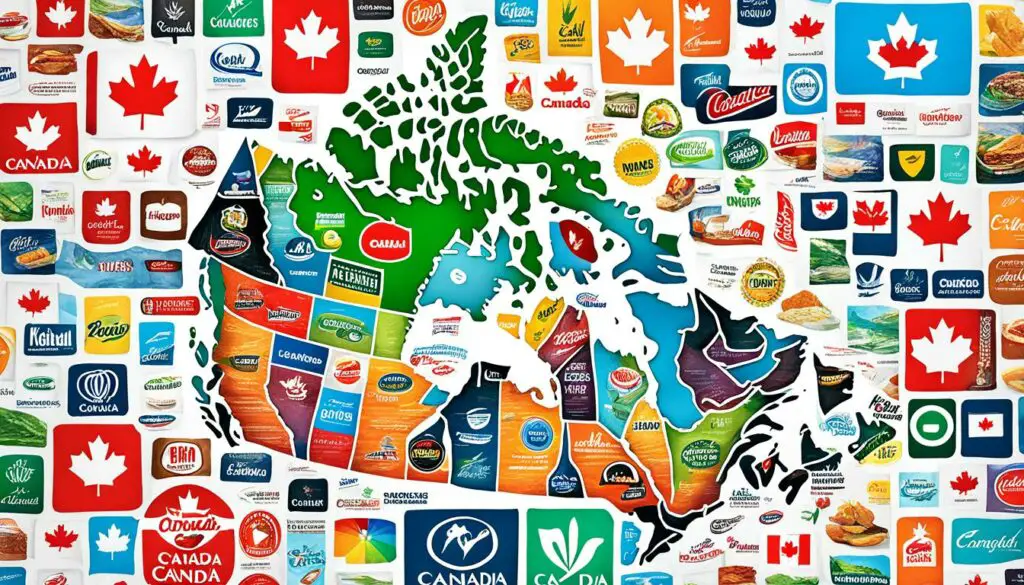Welcome to our article on the Canadian grocery industry! In this article, we will be diving into the fascinating world of grocery stores in Canada and uncovering some quick facts that you may find interesting. Whether you’re a Canadian resident or just curious about the country’s retail landscape, this article will provide you with valuable insights. Let’s get started!
Table of Contents
Key Takeaways:
- Canada’s grocery industry is concentrated, with three major players – Loblaws, Sobeys, and Metro – reporting over $100 billion in sales and $3.6 billion in profits in 2022.
- The industry has seen increased consolidation in recent years, making it difficult for new players to enter and compete effectively.
- There is a need for more grocery competition in Canada to improve consumer choice and lower prices.
- The emergence of online grocery shopping and the growth of e-commerce have transformed the Canadian grocery industry.
- Encouraging the entry of international grocers into the Canadian market can enhance competition and benefit consumers.
The State of the Supermarket: Grocery Competition in Canada
The Competition Bureau report provides valuable insights into the state of grocery competition in Canada. The study reveals that the country’s grocery industry is highly concentrated, with most Canadians shopping at stores owned by a few major players. Loblaws, Sobeys, and Metro, the dominating supermarket chains in Canada, collectively operate thousands of stores across the country, contributing to their market dominance. This concentration poses challenges for small regional independents, making it difficult for them to break into the market and compete effectively.
The report emphasizes the importance of increasing grocery competition to benefit Canadian consumers and promote innovation within the industry. By fostering a more competitive landscape, consumers can have access to a wider range of options, lower prices, and enhanced product quality. Moreover, increased competition can drive innovation, leading to the introduction of new and improved offerings in the grocery market.
To understand the significance of grocery competition in Canada, let’s take a closer look at some supermarket statistics:
| Supermarket Chain | Number of Stores |
|---|---|
| Loblaws | 1,050+ |
| Sobeys | 1,500+ |
| Metro | 600+ |
This data highlights the extensive presence of these major supermarket chains throughout Canada, underscoring their dominant market share. These chains not only shape the grocery shopping experiences of most Canadians but also influence pricing, product availability, and overall competition in the industry.
As the competition landscape evolves, it is vital to address the challenges faced by small regional independents and promote a more dynamic grocery market. Encouraging new players to enter the industry can spur competition, leading to greater choices, competitive prices, and improved customer experiences. Innovation is also more likely to thrive with a diverse and vibrant marketplace.

Consolidation Among Canada’s Grocers
The Canadian grocery industry has experienced a significant increase in consolidation among its major players in recent years. The Competition Bureau study highlights the dominance of renowned food retailers such as Loblaws, Sobeys, and Metro, who have expanded their market share through strategic acquisitions and mergers. This consolidation trend has resulted in a more concentrated industry landscape, presenting challenges for smaller retailers looking to compete effectively.
As a consequence of consolidation, consumer choice in the Canadian grocery market has become limited. The reduced number of independent and regional grocers has led to a potential impact on prices, as major retailers have increased control over the market. The data from the report provides crucial insights into the state of the industry and emphasizes the need for proactive policies to foster competition and support the growth of independent and regional grocers.
To better understand the extent of consolidation, let’s take a closer look at the market share held by the major players:
| Company | Market Share (%) |
|---|---|
| Loblaws | 30.5% |
| Sobeys | 23.1% |
| Metro | 18.6% |
This data clearly demonstrates the significant market dominance of these three major retailers. With a combined market share of over 70%, the consolidation trend in the Canadian grocery industry is undeniable. The limited presence of smaller players has resulted in less competition and potentially higher prices for consumers.
However, it’s important to note that the Competition Bureau study recognizes the need for policies that encourage competition and level the playing field for independent and regional grocers. By supporting the growth of these businesses, the industry can enhance consumer choice, drive innovation, and promote fair pricing.
Supporting Independent and Regional Grocers
The Competition Bureau report underlines the importance of nurturing independent and regional grocers, as they offer unique products and personalized services that contribute to the diversity of the Canadian grocery market. By implementing policies that support these businesses, such as providing financial assistance, promoting local sourcing, and offering business development programs, the industry can foster greater competition and consumer benefits.
“Consolidation in the grocery industry is a challenge, particularly for smaller retailers. Policies that encourage competition and support independent and regional grocers are vital for a healthy and diverse grocery market.”
Moreover, establishing a level playing field for all grocers is crucial to ensure fair competition. This involves creating regulations that prevent anti-competitive practices, such as exclusive supplier agreements or restrictive lease agreements, which can hinder the entry and growth of independent retailers.
In summary, the consolidation among Canada’s grocers has significantly impacted the grocery market, leading to a more concentrated industry dominated by major players. The Competition Bureau study calls for policies that prioritize competition and support the growth of independent and regional grocers to enhance consumer choice and promote fair pricing. It is essential to strike a balance between allowing healthy market competition and ensuring the survival and success of diverse grocery businesses in Canada.

Online Grocery: The New Supermarket?
The Canadian grocery industry has experienced a significant shift with the emergence of online grocery shopping. Consumers now have the convenience and choice of exploring a virtual supermarket from the comfort of their homes. The growth of e-commerce and grocery delivery services has revolutionized the way people shop for groceries, offering a new level of flexibility and convenience.
However, the Competition Bureau report highlights that new online grocery players face certain barriers in establishing their presence in the market. One of the primary challenges is the high costs associated with building and maintaining online platforms. From website development to logistics and delivery infrastructure, the initial investment required can be substantial.
Despite these challenges, the report emphasizes the importance of supporting the emergence of new types of grocery businesses, including online retailers. Encouraging competition and innovation in the online grocery sector can lead to improved services, increased efficiency, and better prices for consumers.
The Benefits of Online Grocery Shopping
Online grocery shopping offers numerous advantages to consumers. Here are some of the key benefits:
- Convenience: With online grocery platforms, shoppers can browse and purchase products at any time, from anywhere with an internet connection. This eliminates the need to physically visit a store and saves time and effort.
- Wide Product Selection: Online grocery stores often offer a broader range of products compared to traditional brick-and-mortar stores. Customers can easily access a variety of brands, flavors, and sizes, allowing them to find exactly what they need.
- Flexible Delivery Options: Grocery delivery services provide flexibility in choosing delivery time slots, allowing customers to schedule deliveries according to their convenience. This is particularly beneficial for individuals with busy schedules or limited mobility.
- Personalization and Recommendations: Online platforms can gather customer data and preferences, which enable personalized product recommendations and tailored shopping experiences. This can enhance customer satisfaction and ensure a more efficient shopping process.

Despite the growth and potential of online grocery shopping, the report acknowledges the need for continued support and investment in the sector to overcome the barriers faced by new players. By promoting competition and creating an enabling environment for online retailers, the Canadian grocery industry can evolve to meet the changing needs and preferences of consumers.
Bringing International Grocery Players to Canada
The Competition Bureau report highlights the potential benefits of introducing international grocers into the Canadian market, leading to increased competition and improved conditions for consumers. While Canada’s grocery industry is dominated by a few major players, the entry of foreign retailers can diversify the market, driving down prices and enhancing product quality. However, independent grocers face significant challenges in scaling up to become national competitors.
By attracting international and discount grocers, Canada can experience a much-needed expansion in the grocery market, fostering innovation and consumer choice. The report recommends collaboration between federal, provincial, and territorial authorities to facilitate the entry of international retailers, creating an environment that promotes healthy competition and supports the growth of independent grocers.
To illustrate the impact of international grocers in Canada, let’s take a closer look at some examples:
Examples of International Grocery Players in Canada
| Company | Country of Origin | Number of Stores in Canada |
|---|---|---|
| Trader Joe’s | United States | 20+ |
| ALDI | Germany | 150+ |
| T&T Supermarket | Taiwan (subsidiary of Loblaw Companies Limited) | 30+ |
International grocers like Trader Joe’s, ALDI, and T&T Supermarket have successfully established a presence in the Canadian market, offering a unique range of products and competitive pricing. These retailers have provided consumers with alternatives and fresh shopping experiences, further highlighting the need for international grocery players in Canada.
Additionally, the entry of foreign retailers can stimulate local economies, creating job opportunities and driving economic growth. By welcoming international grocers, Canada can benefit from their expertise, operational efficiencies, and commitment to customer satisfaction, ultimately raising the bar for the entire grocery industry.

In summary, encouraging the entry of international grocers in Canada is crucial for expanding the grocery market, empowering consumers, and fostering healthy competition. Through strategic collaboration and support from all levels of government, Canada can create a vibrant and diverse grocery industry that meets the evolving needs and preferences of its population.
Informing Consumers
The Competition Bureau report emphasizes the importance of empowering consumers through informed purchasing decisions and grocery price comparison. To achieve this, the study recommends that provincial and territorial governments introduce accessible and harmonized unit pricing requirements in grocery stores. Unit pricing enables consumers to compare prices on similar items across different stores, providing transparency and fostering competition in the industry.
This initiative aims to break down barriers and empower consumers to make more informed choices when shopping for groceries. By implementing unit pricing requirements, consumers will have the ability to easily compare prices and determine the best value for their money.
Unit pricing requirements give consumers the power to assess the true cost of a product based on its size or quantity, rather than relying solely on the overall price tag. This enables them to make more informed decisions and stretch their budgets further. Additionally, unit pricing helps promote healthy competition among grocery stores, pushing them to offer competitive prices and ultimately benefiting consumers.
Unit pricing requirements have already been successfully implemented in various countries, including Australia, the United Kingdom, and South Africa. These countries have recognized the positive impact unit pricing has on consumer empowerment and informed decision-making.
“Unit pricing provides consumers with a level playing field, allowing them to easily compare prices and make informed decisions about which products best suit their needs and budgets.”
With unit pricing requirements in place, consumers no longer need to rely solely on advertising campaigns or temporary discounts to gauge product affordability. Instead, they have a reliable and consistent method of comparing prices, helping them save on their grocery bills and prioritize their spending.
Importance of Consumer Empowerment
Implementing unit pricing requirements in grocery stores is a positive step towards consumer empowerment. By providing consumers with transparent and accessible pricing information, they can feel confident in their purchasing decisions and have greater control over their spending. With the ability to easily compare prices, consumers can choose the products that best align with their budget and personal preferences.
Moreover, unit pricing requirements foster competition among grocery stores, encouraging them to keep prices competitive and ensure their offerings appeal to cost-conscious consumers. This creates a marketplace where customers have more options and are not limited to a select few retailers.
Unit pricing empowers consumers by:
- Enabling easy price comparison across different grocery stores
- Promoting informed decision-making based on the true cost of products
- Encouraging grocery stores to offer competitive prices
- Fostering a more transparent and consumer-friendly marketplace
By implementing unit pricing requirements in grocery stores, provincial and territorial governments can play a crucial role in empowering consumers, enhancing competition, and shaping a more consumer-centric grocery industry.
Canadians’ Ideas for Increasing Grocery Competition
As part of the Competition Bureau study, a public survey was conducted to gather Canadians’ opinions and ideas for increasing grocery competition. The survey aimed to understand consumers’ perspectives and incorporate their suggestions when formulating policies to enhance the grocery industry..
The report revealed that Canadians expressed a strong desire for more options, lower prices, and increased product quality. They emphasized the need for a more diverse and competitive grocery market that caters to their evolving needs and preferences.
Key Survey Findings:
- 81% of respondents agreed that supporting local and independent grocers is vital for fostering competition and diversity in the industry.
- 67% of Canadians emphasized the importance of promoting transparency in pricing to enable informed decision-making and encourage fair competition.
- 56% of participants suggested encouraging the entry of new players, such as discount and international retailers, to introduce more competition and innovation into the market.
Through these suggestions, Canadians hope to see increased competition that not only benefits consumers with more choices and lower prices but also incentivizes grocery retailers to improve product quality and customer service.
“Having access to a wider range of grocery options means better selection and prices for us as consumers. It’s essential to support local businesses while encouraging new players to enter the market.” – Survey respondent
Consumer-Centric Strategies:
To address these consumer concerns and drive competition, the Competition Bureau report recommends several strategies:
- Supporting Local and Independent Grocers: By investing in programs that enhance the viability and growth of local and independent grocers, the industry can diversify and promote healthy competition.
- Promoting Transparency in Pricing: Encouraging grocery retailers to adopt standardized pricing practices and providing consumers with accessible price comparison tools can empower them to make informed purchasing decisions.
- Facilitating Entry of New Players: Creating an environment that encourages the entry of discount and international retailers can introduce new competition and innovative business models that benefit consumers.
By incorporating Canadians’ opinions and suggestions, policymakers can develop a comprehensive approach that fosters grocery competition, ultimately improving the overall shopping experience for consumers in Canada.
| Survey Recommendations | Agreement Percentage |
|---|---|
| Support local and independent grocers | 81% |
| Promote transparency in pricing | 67% |
| Encourage entry of new players | 56% |
Recommendations to Increase Grocery Competition in Canada
The Competition Bureau report provides four recommendations to governments across Canada to promote grocery competition and benefit consumers. These recommendations are crucial to enhancing choice, lowering prices, and encouraging innovation in the Canadian grocery industry.
1. Implement a Grocery Innovation Strategy
The competition bureau suggests implementing a comprehensive Grocery Innovation Strategy to support the emergence of new types of grocery businesses. This strategy would provide necessary resources and incentives for innovative startups and small-scale entrepreneurs to enter and thrive in the grocery market. By fostering competition and supporting new players, the industry can experience increased dynamism and consumer benefits.
2. Encourage the Growth of Independent Grocers and the Entry of International Retailers
To diversify the grocery industry and promote healthy competition, governments should focus on fostering the growth of independent grocers. This can be achieved by providing them access to financing, market intelligence, and mentorship programs. Additionally, attracting international retailers to enter the Canadian market can inject new competition, introduce diverse product offerings, and spur innovation.
3. Introduce Accessible and Harmonized Unit Pricing Requirements
Unit pricing is a powerful tool that empowers consumers to compare prices on similar items across different grocery stores. The competition bureau recommends introducing accessible and harmonized unit pricing requirements at the provincial and territorial level. This will enable consumers to make informed decisions and effectively navigate the grocery market, fostering competition based on price transparency.
4. Take Measures to Limit Property Controls in the Grocery Industry
The competition bureau encourages governments to take proactive measures to limit property controls that hinder competition in the grocery industry. By addressing barriers such as restrictive leasing agreements and exclusive arrangements, decision-makers can promote fair competition and create a level playing field for all market participants. This will stimulate innovation and encourage new entrants to compete effectively.
Implementing these recommendations in a pro-competitive manner will be essential for enhancing grocery competition in Canada and driving positive outcomes for consumers. Collaboration between the Competition Bureau, governments, and stakeholders is crucial in implementing these recommendations effectively.
| Recommendations | Benefits |
|---|---|
| Implement a Grocery Innovation Strategy | Increase competition, foster innovation, and support new grocery businesses. |
| Encourage the Growth of Independent Grocers and the Entry of International Retailers | Diversify the industry, expand product offerings, and stimulate innovation. |
| Introduce Accessible and Harmonized Unit Pricing Requirements | Empower consumers, promote price transparency, and enable informed decision-making. |
| Take Measures to Limit Property Controls in the Grocery Industry | Create a level playing field, stimulate competition, and support new entrants. |
Conclusion
The Competition Bureau’s Retail Grocery Market Study Report sheds light on the current state of the Canadian grocery industry and emphasizes the need for increased competition. The industry’s concentration, dominated by major players like Loblaws, Sobeys, and Metro, presents challenges for small business owners and new entrants. This consolidation has limited consumer choice and potentially impacted prices.
However, the report also offers recommendations to empower consumers and promote competition. By implementing these suggestions, Canada can create a more vibrant and competitive grocery industry. Lower prices, improved product quality, and increased innovation are some of the benefits that consumers can enjoy in a more competitive marketplace.
Moreover, the report highlights the growing trend of online grocery shopping and the potential of international grocers entering the Canadian market. These developments can provide consumers with more convenience, choice, and additional competition.
Overall, the Competition Bureau’s report provides valuable insights and recommendations for governments and industry stakeholders. By taking proactive measures to foster competition, Canada can pave the way for a brighter future in the grocery industry, benefiting both consumers and businesses.
FAQ
How many grocery stores are there in Canada?
The exact number of grocery stores in Canada can vary, as new stores open and others close. However, the grocery industry in Canada is dominated by major players like Loblaws, Sobeys, and Metro, who collectively operate thousands of stores across the country.
What are some supermarket chains in Canada?
Some of the major supermarket chains in Canada include Loblaws, Sobeys, Metro, Walmart, Costco, and Safeway.
Why is grocery competition important in Canada?
Grocery competition is important in Canada because it promotes consumer choice, lower prices, and innovation in the industry. Increased competition can lead to a wider range of options for consumers and encourage retailers to improve their products and services.
Source Links
- https://en.wikipedia.org/wiki/Loblaw_Companies
- https://www.ctvnews.ca/canada/here-s-how-canadians-view-big-grocer-loblaw-co-expert-1.6735031
- https://ised-isde.canada.ca/site/competition-bureau-canada/en/how-we-foster-competition/education-and-outreach/canada-needs-more-grocery-competition
See also:
Leave a Reply